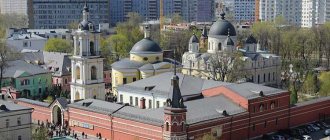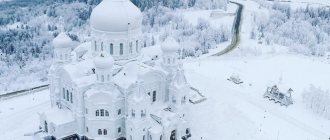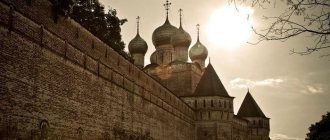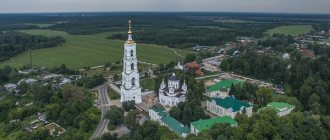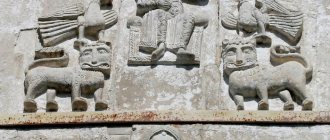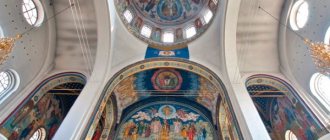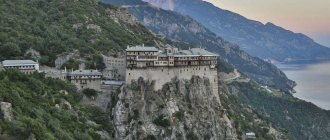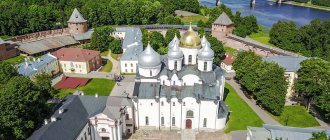The Valaam Transfiguration Monastery of the Russian Orthodox Church is located on the islands of the Valaam archipelago in Karelia, on the northern outskirts of Russia, near the border with Finland. The Valaam archipelago consists of 50 separate islands located in Lake Ladoga, 22 km from the mainland. The holy monastery occupies the largest island - Valaam, 9.6 km long and 7.8 km wide. The Valaam Monastery - stauropegial - is subordinate to the Patriarch of Moscow and All Rus', but in fact the abbot controls the monastery.
Where is the Valaam Monastery located?
The holy monastery is located in Karelia, on a huge island in the northern part of Lake Ladoga, or rather on an entire archipelago of more than 50 individual islands. The largest of them is the island of Valaam, but other areas of land also belong to the territory of the monastery.
Valaam and the coast are separated by about 22 km. The nearest settlement near Valaam is the city of Sortavala, it is located 42 km from the monastery. Despite the fact that from the map it seems that the Valaam Monastery is located not far from St. Petersburg, in fact it is more than 200 km from the northern capital to the holy monastery.
Description of the Valaam Monastery
The Valaam Monastery in Karelia belongs to the category of stauropegial, which means that the monastery is directly subordinate to the Patriarch of Moscow and All Rus', although the actual management of the monastery according to the ancient charter is carried out by the abbot.
The ancient holy monastery occupies the huge island of Valaam with an area of about 30 square meters. km, the monastery's hermitages are scattered across fifty small islands in the immediate vicinity. The monastery is located in a very picturesque corner of nature - a rocky island rises high above sea level, the territory of Valaam is covered mainly by pine forests. The island has several internal lakes and a network of canals, artificially created in the 19th century.
In the video of the Valaam Monastery you can see that the monastery complex is very large and difficult to explore in one day. The monastery includes many churches, chapels and memorial crosses. Among the most famous buildings are the Transfiguration Cathedral and the White and Red Monasteries, the Church of the Assumption of the Blessed Virgin Mary, and the ancient houses of the Valaam Monastery.
On the territory of the Spaso-Preobrazhensky Valaam Monastery there are many outbuildings - a hotel founded in the ancient building of the Stable House, a Waterworks House, a bakery and a dairy farm, its own vehicle fleet and a modern outpatient clinic. The monastery owns arable land and orchards; the Valaam Monastery farm operates on the island. Throughout the year, the monks work on Valaam in the same way as in the old days, since the life of the island consists not only of prayers, but also of constant work.
Temples and shrines
To get to the monastery, you need to climb the mountain 30 meters above sea level. Mount Tabor on Valaam is surrounded on three sides by gardens that have been cultivated by monks for centuries. Opposite the entrance to the monastery there is a chapel, in the center of which is the icon of the Mother of God “The Sign”. The chapel was erected in 1862 in memory of the visit to the monastery by Emperor Alexander II and members of his family. Called Tsarskaya, it is built of Karelian marble with a plinth of gray granite.
The structure is in the form of a stone arch with a triangular pediment, into which is inserted a stone medallion with a carved inscription about the visit of the monastery by the royal family. Famous writers, artists and composers also loved to visit the holy protected place.
Not far from the Holy Gates of the monastery there is a monument to St. Andrew the First-Called . One of the 12 apostles, Andrew the First-Called was the first called by Jesus Christ to preach the Gospel. Traveling from Crimea to Rome through Ladoga, the Apostle Andrew set foot on the islands of the Valaam archipelago. In 2003, the relics of the Apostle Andrew, whose name is revered in Rus', were brought to Valaam from Greece. The monument to the first disciple of Christ was consecrated on Valaam in 2014 by Patriarch Kirill of Moscow and All Rus'.
The Transfiguration Cathedral is seen by everyone who arrives on the island. The lower church was consecrated in the name of St. Sergius and Herman, Valaam wonderworkers. Under the cover of the lower church of the Transfiguration Cathedral lie the relics of Saints Sergius and Herman. Above the shrine is the image of “The Lord Almighty with those coming” depicting the Venerables Sergius and Herman kneeling in prayer at the Valaam monastery. In the year of the 10th anniversary of the resumption of monastic life in the monastery, the icon streamed myrrh.
In the cathedral there is a copy of the Valaam Icon of the Mother of God. The Virgin Mary, dressed in a dark cherry cloak, holds the Child, whose left hand blesses. Through prayers at the Valaam Icon of the Mother of God, hundreds of sick people received healing. In 2005, for an unprecedented mission, a smaller copy was painted from the icon. From October 8 to October 11, she circled the Earth more than a thousand times aboard the Soyuz spacecraft.
A granite staircase with images of Russian saints along the walls leads to the Upper Church of the Transfiguration of the Lord. The bright, spacious and formal hall seats 3,000 people. The temple, built in 1896 in the Russian style, used 3.5 million bricks, which were prepared on the island from local clay. The walls and iconostasis were painted by monks from the Valaam school of painting.
During the Soviet years, the abandoned temple was slowly destroyed. Restoration began in 1980. On August 19, 2005, on the day of the Transfiguration of the Lord, the Ptriarch of Moscow and All Rus' consecrated the monastery cathedral.
The Gate Church of the Holy Apostles Peter and Paul is located above the Holy Gates - the main entrance to the monastery. The church was built in the style of Russian classicism, the decoration of the temple is austere. In 1940, the gilded columns that decorated the iconostasis were removed and used for decoration in the club. The temple is being restored.
Temple of the Holy Life-Giving Trinity and the Life-Giving Spring icon with a simple architectural appearance. The facade is decorated with cornices of complex profile and icons in medallions. This is a hospital temple. In 1814, a church was built in honor of the Life-Giving Spring icon. On the initiative of the benefactors of the temple, in 1837 a new, upper part of the temple was built and consecrated in honor of the Life-Giving Trinity.
The Church of the Assumption of the Blessed Virgin Mary was consecrated as a refectory church in 1785. It was built as a simple square building, topped with a small onion bed on a thin, blind drum. The walls of the temple are cut with shovels. During Soviet times, the building was occupied by a village store, but here 11 icons, painted in the 18th century specifically for the iconostasis, have been preserved in their places.
Every year, from May 22, the monastery is visited en masse by pilgrims, whose crossing takes place by water. Here you can venerate the relics of the righteous Anna - by touching the shrine, the relics of the mother of the Blessed Virgin Mary, Christian women get rid of infertility.
The relics of the prophet and Baptist John the Baptist, the Evangelist Matthew, the Apostle Paul and the Apostle Andrew the First-Called on Valaam are miraculous. Valaam is that corner on an island remote from civilization where every person will find something close, dear and intimate.
Hermitages of the Valaam archipelago
The monasteries of the Valaam Monastery deserve special consideration. The small temples and residential buildings on the small islands of the archipelago have great religious significance and a rich history.
White Monastery
The White Skete, or Skete of All Saints, is located on the Skete island of the same name. The monastery was founded at the end of the 17th century; initially it had several fraternal buildings and a stone church. The White Skete has particularly strict rules - female pilgrims are practically prohibited from entering here; you can only visit the territory of the skete on All Saints' Day during a religious procession.
Skete of John the Baptist
The monastery on Predtechensky Island was built in 1855 and at that time was a simple wooden chapel. In 1858, a wooden church with a bell, cast especially for the Valaam Monastery under Boris Godunov, was erected in its place. At the beginning of the 20th century, ancient crosses from the 17th and 18th centuries were kept in the monastery, as well as the ashes of Schemamonk Jonah, revered on Valaam.
Currently, monks still live in the monastery. However, you cannot go on an excursion to the monastery - the Forerunner Monastery is completely closed to visitors.
Red Monastery
The Red Monastery, which is also called the Resurrection or New Jerusalem, is located in the southern region of the island of Valaam. According to legend, it was on this spot that the cross was originally installed by the Apostle Andrew the First-Called himself. In 1846, a wooden chapel was erected on the site of the cross, and at the beginning of the twentieth century it was replaced by a two-story church. The monastery received its unofficial name, Red, because its buildings are made of red brick.
Monastery of St. Nicholas the Wonderworker
The small monastery on Cross Island was built in the mid-19th century and initially consisted of the Church of St. Nicholas the Wonderworker and the Church of St. John of Damascus. A few years after construction, a stone building with cells for the brothers was added; also in the 19th century, a lighthouse was located in the chapel of St. Nicholas the Wonderworker; lanterns were lit in the windows on especially dark nights.
Konevsky monastery
Konevsky monastery is located on Konevets Island on the shore of Lake Igumenskoye. The consecration of the monastery took place in 1870, but in the middle of the 20th century, under Soviet rule, the monastery was dismantled. In 2004 it was restored and re-consecrated. The monastery is known for the fact that in former times, not far from it, there was a cell of Hegumen Damascene, the abbot of the monastery from 1839 to 1881, who made a great contribution to the development and prosperity of Valaam.
Gethsemane Monastery
Gethsemane, or Yellow, monastery is located near the Mount of Olives and includes the Ascension Chapel, the Chapel of the Prayer of the Chalice and the Church of the Assumption of the Blessed Virgin Mary. The monastery was founded at the beginning of the twentieth century, but during the years of Soviet power it suffered quite a lot; restoration work is still underway on the territory of the monastery. The skete was re-consecrated in 1998.
“The main thing is to be with God”
– How many monks, monks, and novices are there in the monastery today? How many workers constantly work at the monastery?
– The total number of inhabitants of the monastery is 217 people, including the monastery’s monasteries and courtyards. Of them:
• hieromonks – 37 • hierodeacons – 12 • monks – 89 • cassock novices 19 • novices – 60
From 30 to 40 workers constantly work on the island.
– How do you usually get to the monastery?
– Usually we ask for a recommendation or blessing from an elder, a priest, a bishop. But it happens that a person arrives who is just beginning to become a church member, but who feels a craving for monastic life, a desire to work hard and test himself. We don’t refuse this either. He becomes a church member at the monastery, and then it becomes clear to both him and us whether he can be a candidate for the brethren or not.
This is a living matter and not at all formalized. Some come themselves, others apply via the Internet or write regular letters asking for blessings to come. It happens in different ways, the main thing is the desire for monastic life. But not because there is nowhere else to go - this is the worst option. The main thing is the calling of God, when life in the world is not of interest, neither career, nor money, nor even family, nor the most innocent pleasures are important; when the main thing in life is to be with God. That is why, in fact, a person comes to the monastery.
– Are there hermits or closed hermitages on Valaam today?
– By tradition, the largest monastery in the name of All Saints is quite closed: women are allowed there once a year on the patronal feast. There is the Forerunner Skete, where the presence of women is generally prohibited. So about the Monastic Island, where this monastery is located, we can rightfully say that this is northern Athos. The same principle applies here as on the Holy Mountain. In part, this is a tribute to the tradition that has been established in these monasteries since ancient times.
But at the same time, secluded places where the brethren can follow the monastic path in calm conditions are truly necessary. Usually in monasteries both the cell rule and the liturgical service are longer than in the monastery itself. There is less time left for labor obedience. Many brothers strive to get into the monastery, but we try to send there those who are already prepared. After all, a solitary life (not yet a hermit life) is a very special case.
– Are there many such ascetics on Valaam?
– We have brothers who lead such a life, but I would not like to tell where and how - this is a secret matter. They did not go into seclusion in order to proclaim this to the whole world, to be visited by pilgrims, admirers, spiritual children, and so on.
Who founded the Valaam Monastery
The identity of the founder of the Valaam Monastery and the exact year of its foundation still remain in question. The monastery is so ancient that there is simply no reliable evidence of the beginning of its existence.
- Based on the life of St. Abraham of Rostov, it is suggested that the monastery was founded at the beginning of the 10th century by the monks Herman and Sergius, who came to Valaam from the Mediterranean and founded a monastic brotherhood on the island. At the same time, there are no written sources that would tell about the life of the monks themselves, but a number of chronicles mention the transfer of their relics in 1163 from Valaam to Novgorod.
- According to the texts of the life of Savvaty Solovetsky, the year of foundation of the monastery on Valaam is considered to be 1407.
- According to legend, the founder of the Valaam monastery is the Apostle Andrew the First-Called himself, who brought the good news of Christ to the northernmost lands and erected a stone cross on the rocks of Valaam.
Attention! In fact, it is possible to trace the history and development of the Valaam monastery only from the 16th century; it was during this period that references to the monastery begin to appear frequently in written sources.
What is Valaam Monastery famous for?
It is not for nothing that the Spaso-Preobrazhensky Valaam stauropegic monastery is one of the most famous monastic monasteries in Russia and the whole world. Every year tens of thousands of pilgrims come here, attracted by the ancient history of the monastery, the stunningly beautiful nature of Valaam and the special atmosphere that reigns on the island remote from civilization.
- Valaam is one of the most ancient monasteries in the Christian world. The legend directly connects its foundation with Christ’s disciple Andrew the First-Called, and even according to reliable written sources, the age of the monastery is at least 500 years.
- Valaam is located in an amazingly beautiful and clean natural area and is located at a considerable distance from the “world”, thanks to which during a trip to Valaam you can truly relax your soul from ordinary worries.
- On the vast territory of the Valaam Monastery there are many historical buildings and ancient temples, some of them have been preserved from ancient times, others have been restored in modern times. Valaam is of interest not only to pilgrims, but also to historians and cultural experts around the world.
- Many important Orthodox shrines are kept within the walls of the monastery - every year pilgrims come here to venerate the images and relics, ask for healing or enlightenment.
One of the most important features of the Valaam Monastery on Lake Ladoga is its particularly strict internal charter. It is not for nothing that the monastery is called “northern Athos” - the monks of Valaam avoid any worldly temptations, preach strict asceticism, work hard and truly devote their lives to serving God.
History of the Valaam Monastery
The exact date of foundation of the Valaam Monastery remains unknown - some sources place the foundation of the monastery in the 10th century, according to others, the monastery was founded in the 14th century. It is officially accepted that the history of the monastery began in 1407, and its founders were the pilgrims Herman and Sergius.
The monastery experienced its greatest prosperity in the 15th-16th centuries, when about 600 monks lived on its territory. At the beginning of the 17th century, Valaam fell into decline; during this period the island came under the control of Sweden, as a result of which the monastery was severely devastated. After the Northern War, the island returned to the borders of Russia, and by order of Peter I, the restoration of the monastery began in 1715.
In 1730, the wooden Assumption Cathedral was erected, but it did not last long; a fire in 1754 destroyed almost all the buildings. The next restoration of the monastery was facilitated by Empress Elizabeth. In 1774, the Cathedral of the Transfiguration of the Lord, the Assumption and St. Nicholas churches, as well as cell buildings were erected. Another 10 years later, under Abbot Nazariya, stone construction began on the territory of the monastery.
With the beginning of the 19th century, Valaam flourished again; active development was carried out on the territory, some of which has survived to this day. In 1839, the famous abbot of Damascus became the abbot of the monastery, who made a huge contribution to the architectural development of the monastery. Damascene not only initiated the construction of new cathedrals and churches, but contributed to the revival of classical monastic traditions in the monastery. The eldership was returned again, the rules of the monastery became much stricter, and its fame increased.
At the end of the 19th century, the number of inhabitants of the monastery was about 1000, and there was also a tendency to assign names from the New Testament to the surrounding area of the temple. The clergy hoped that soon the Valaam Monastery of the Transfiguration of the Savior could become the new Jerusalem.
In the twentieth century, difficult times came to Valaam. After the revolution, the monastery was not closed, since it was located not in Russia, but in Finland. However, changes came anyway, since Orthodox believers in Lutheran Finland were in the minority, and in 1923 the monastery was de-Russified. Divine services began to be held there in Finnish, and defensive structures were placed on the territory of the monastery in case of war with the Soviet Union. The monastery was forced to switch to the Gregorian calendar, and many monks left the monastery. During the Finnish-Soviet war, the exodus of monks from the Valaam Monastery intensified - the monks went to Finland and subsequently founded the New Valaam Monastery there.
In the 1930s, only about 400 monks remained in the monastery, suffering poverty and hunger. In 1940, after the return to the USSR, the monastery was finally closed, and a naval school was located on the territory of the monastery. In 1950, the territory of the monastery was given over to a home for the disabled, and in 1979 a museum-reserve was opened on Valaam.
The revival of the monastery began only in 1989, the Orthodox Church again took possession of most of the monastery buildings. In December 1989, 6 monks settled on the island, trying to revive the traditions and customs of Valaam, and in 1994 the monastery was re-consecrated.
Shrines of the Valaam Monastery
On the territory of the Valaam monastery there are many important shrines of the Orthodox world. Among them are:
- the relics of the venerable monks Sergius and Herman, they are kept in the Transfiguration Cathedral of the Valaam Monastery and are an object of worship for pilgrims from all over the world;
- The Valaam Icon of the Mother of God, a miraculous image painted in 1878 by the monk Alypius;
- the icon of St. Anna, this image is an exact copy of the original kept on Mount Athos, and according to legend, it saves women from infertility.
Also on Valaam there is a piece of the Holy Sepulcher from the Holy Land - the relic is kept in the Resurrection Skete of the monastery.
Monks of the Valaam Monastery
The Valaam Monastery on the marvelous island of Valaam is famous for its strict rules, which largely repeat the traditions of the famous Athos. Currently, more than 200 monks live in the monastery, busy daily with prayers and hard work. The daily routine for the brethren of Valaam is as follows:
- at 17 o'clock in the evening, Little Compline begins in the monastery, followed by the monastic rule, three canons with an akathist to the Mother of God and the rite of forgiveness;
- at 21 o'clock after dinner there comes a time of silence, during which the monks read prayers in private and bow;
- at 22 o'clock one goes to bed, and already at 5 o'clock in the morning the Midnight Office and Matins take place;
- after this, an early liturgy is served, after which the monks go to morning tea and subsequent obediences;
- At 1 p.m., lunch follows, after which the works of the holy fathers are read and a prayer service is served at the relics of St. Herman and Sergius.
A feature of the life of monks is that each of the monks is under the authority of a spiritual father or abbot. The time and duration of cell prayers are determined individually for each monk.
Strict rules apply on the territory of the Valaam Monastery regarding the sleep of monks. At night, 4 to 5 hours are allotted for rest; monks can sleep another 1-2 hours during the day after lunch. According to the abbot of the Valaam Monastery, Hegumen Pankratiy, the rule on the duration of sleep is taken from the patristic books; they recommend sleeping no more than 6-7 hours.
Important! The choir of the Valaam Monastery is very famous; its members include graduates of the Choir School named after. Glinka and the St. Petersburg Conservatory. Rimsky-Korsakov, certified vocalists and conductors, singers of musical theaters and vocal groups of St. Petersburg.
Prayer and work
– Vladika Pankratiy, the Valaam Monastery is famous for its strict regulations.
Could you tell us about the life of the Valaam brethren under the existing charter? – Valaam is northern Athos, and the rules in the monastery are strict. But the severity must be justified. The Lord said in the Gospel: “The Sabbath is for man, and not man for the Sabbath” (Mark: 2, 27). All church institutions, divine services, and sacraments direct a person on the path of salvation, overcoming sin, evil, and predetermine spiritual growth and strengthening in virtues. When the inner side is neglected, the outer side helps little, and even harms.
A person can grow up to be a Pharisee who does not monitor his inner world at all, allowing himself both thoughts and deeds that are reprehensible. Therefore, in any monastery everything should be harmonious and balanced. After all, a monastery is, first of all, a place where you can best fulfill the commandments of the Gospel and realize Christian ideals in your life.
Prayer and work are two oars that need to be rowed at the same time. Moving straight requires both work and prayer. If you put more weight on one of the oars, it means that you will either go to the side or start spinning. Both church prayer, cell prayer, and the work of the brethren must be harmonious, balanced in such a way that time and energy remain for attentive cell prayer, but at the same time there would be an opportunity to pray together in church and work on obediences.
Therefore, we do not strive for absolute accuracy in the implementation of some of the statutory instructions of the same Typikon. Although, of course, we preserve the spirit of the Typikon, the structure of the service itself, its structure and features. They contain many spiritual treasures - both dogmatic and doctrinal, which help, edify, inspire, touch the soul and heart. So daily participation in the service, in general church prayer, is certainly necessary: at least 2-3 hours in the morning and the same time in the evening.
How to get to the Valaam Monastery
The holy monastery, located on the northern outskirts of the country, can be reached both from the capital and from St. Petersburg. It is most convenient to use a car, but there are also public transport routes, although in this case you will have to travel with transfers.
How to get to the Valaam Monastery from Moscow
The easiest way to get to the holy monastery from the capital is to travel by car. From Moscow you need to drive along the Leningradskoye Highway, then along the M10 highway to reach St. Petersburg, go around it and get onto the A121 highway, along which you proceed to Priozersk. You can get to the island from Priozersk by water; a passenger ship and a meteor boat go to the pier of the Valaam Monastery every day.
Another way to get to your destination from the capital is to take a plane or train to first get to St. Petersburg, and then take a regular bus at the Northern Bus Station to Priozersk. Also from the Ladozhsky station you can get to the city of Sortavala and board a motor ship or boat.
How to get to the Valaam Monastery from St. Petersburg
You can also get to Valaam from the northern capital by car; to do this, you need to go to Priozersk along the A121 highway, and then transfer to a motor ship or boat at the city pier.
There are other ways to get to the Valaam Monastery:
- by train to Priozersk - you need to board the train at the Finnish station, the journey takes about 3 hours, and you can get to the pier from the railway station by taxi or bus;
- by regular bus - transport from the Northern Bus Station of St. Petersburg goes to Priozersk daily, the journey also takes about 3 hours;
- by train to Sortavala - you need to board the train at the Ladozhsky railway station; the Sortavala railway station is only 1.5 km from the pier.
Important! In the summer, excursions to the Valaam Monastery from St. Petersburg depart from Petrovskaya Embankment; meteor boats and motor ships go directly to the island. This route allows you to avoid transfers, but the travel time takes about 10 hours.
Main Cathedral
The main building of the cathedral with blue domes was restored from 1987 to 1996.
This is one of the most grandiose cathedrals in Russia. Almost all of the painting was done by monks. It has its own unique symbolism. The name in honor of the Transfiguration of the Lord and the fact that it is located on the highest point of the island tells us that a person’s vices disappear as gradually as he climbs the mountain to God.
Since ancient times, monks have cherished the idea of creating an analogue of Jerusalem on the island - the mountain on which the monastery stands symbolizes Mount Tabor. Many buildings here are based on this idea: the Resurrection Monastery on Mount Zion, the Gethsemane Monastery under Mount Olivet, and so on.
For the interior painting of the walls of the cathedral, the painting of the Cathedral of Christ the Savior in Moscow, Vladimir Cathedral in Kyiv, Kazan and St. Isaac's Cathedrals in St. Petersburg was taken as a basis. And the monks who painted the walls took as a basis the paintings of the greatest artists A. Ivanov, F. Bruni, V. Vereshchagin, A. Egorov, V. Vasnetsov, Raphael, Titian, Dore.
But, of course, they didn’t just copy these works, but created their own, using the artists’ compositions as a basis.
Excursions to the Valaam Monastery
Since Valaam is not only a place of pilgrimage, but also an important cultural site of world significance, you can get to the island as part of a tour of the Valaam Monastery from Moscow or another Russian city.
- There are tours of the estate of the Valaam Monastery and the hermitages of the monastery, group and private excursions with an individual guide.
- On average, tours can take from 1 to 4 days, given the size of the monastery, it is best to go to Valaam on a long tour, this will allow you to see more sights.
- Some tours to Valaam involve active exploration of the island, others are offered in the format of a free holiday, in this case the organizers book accommodation for tourists and deliver to their destination, and after a few days they take travelers back.
- Excursions around the island and the monastery are organized by the Valaam Monastery itself; tickets can be purchased through the monastery’s Pilgrimage Service.
Tourists and pilgrims can stay on the island at the monastery hotels - “Winter”, “Igumenskaya”, “Attic” and “Slavyanskaya”. It is better to book places in advance, since the influx of tourists to Valaam is always very large.
Advice! It is better to plan a trip to the Valaam Monastery in summer and winter. Access to the island is limited; moreover, most of the buildings are not heated and are therefore closed to the public.
Two trips to Athos
– Vladyka, tell us about how you ended up on Valaam?
– I ended up on Valaam completely unexpectedly... In 1992, with a group of pilgrims, we visited Holy Mount Athos, we were there only for a day. For the first time since 1914, we brought the Holy Fire to Russia. And so, together with the group participating in this mission, I ended up on the Holy Mountain and was completely conquered by Athos - it was like an earthly paradise, truly the garden of the Mother of God. Moreover, at that time one could still see old Athos.
Now large-scale restoration work is being carried out there, and thank God. But still something is lost. There are renovated buildings everywhere, excellent decoration, very good roads, comfortable hotels. But you know, there are things that are antique, authentic, real, with their own charm, we understand that they are many years old, sometimes even centuries, and this thing carries some kind of spirit. If it is replaced with the same exact product, but of modern workmanship, then this spirit is lost. The form seems to be the same, but the content is different. And the attitude in the soul.
So, I found that old Athos, when Elder Paisios and other fathers were still alive. Then I went to the Holy Mountain many times, but the first meeting with it was especially piercing, transformative, stunning in the spiritual sense of the word. A very special atmosphere of prayer was felt. Although, of course, living conditions were much worse than now, and moving around Mount Athos was much more difficult. But the Holy Mountain made such an impression on me that I decided to do everything in my power to get to our Panteleimon Monastery and work there. At that time I was a housekeeper at the Trinity-Sergius Lavra, but I submitted a petition, and quite unexpectedly for me, the hierarchy treated him favorably.
Apparently, when the documents were being drawn up, His Holiness somehow found out about me, called me, we talked, and got to know each other. Apparently, he was interested in my recent trip to Athos. Quite unexpectedly for me, a few months later - at the end of 1992 - His Holiness Patriarch Alexy invited me again and said: “You planned to go to Athos, but I want to send you to northern Athos - Valaam.” Well, what could I do? I immediately felt that this was the will of God, and I answered His Holiness that I was his novice, and I would do as he said. So, on Epiphany 1993, a decree on my appointment was signed, and after some time I came to Valaam.
– How did the Holy Island greet you?
– The first impression was shocking. I did not expect to find this ancient monastery in such a deplorable state. Restoration, of course, was carried out, but very little, and by the time of my arrival it was frozen. The laity - about 500 people - even lived in the inner square of the monastery, interspersed with the cells of the monks. But gradually, with God’s help, we managed to overcome a lot. The most important thing is to establish peace and harmony among the brethren in the monastery. And then - continue the restoration, restore the shrines.
– The monks’ thunderstorm is despondency, sadness. How difficult it is in winter, when all around is harsh Ladoga, snow, desolation...
– This is the most precious and most wonderful time on Valaam! And we are never bored, because the consolation of a monk is prayer and spiritual joy. It’s boring and sad just when we are surrounded by crowds of pilgrims and tourists. Crowds! This is the real threat of the monks, and, seriously speaking, a very important problem. It is necessary to somehow regulate the number of visitors - and nature can no longer withstand the onslaught of a hundred thousand in 3 months, and it is difficult for the monks.
But, unfortunately, legal mechanisms in this regard have not yet been created - unlike, for example, Athos. The number of pilgrims who can visit the Holy Mountain is clearly defined there, and each of them is given a special written blessing. The monasteries know how many people will come, how many places need to be prepared in the small hotels that are available. And at the height of the season, from three to five large cruise ships come to us every day for one day, each carrying an average of 300 people.
That is, only up to one and a half thousand tourists visit the Central Estate of the monastery and some monasteries. In the monastery hotels we can accommodate up to 200 pilgrims arriving on our small fleet - small ships. – What are the conditions in these hotels?
– Hotels on the island are different. There are comfortable ones with amenities in every room, but unfortunately there are few of them. Some rooms are quite simple. But the people who come to us are different - there are poor pilgrims who are ready to stay in any conditions, just to pray, visit our shrines, visit hermitages and islands. They are happy with what they have. We are sometimes forced to place beds even in school classrooms due to the fact that, unfortunately, it is not possible to accommodate everyone. Although our conditions for receiving pilgrims are gradually improving.
Rules for visiting the Valaam Monastery
Valaam is a popular tourist destination, but we should not forget that the island belongs to a functioning monastery. For all guests and pilgrims without exception, the Valaam Monastery establishes quite strict rules.
- Guests of Valaam must wear closed clothing; moving around the monastery in sports, beach or open clothes, shorts and miniskirts is unacceptable.
- When entering existing temples, men must remove their hats, and women must cover their heads and wear long skirts.
- Smoking or drinking alcohol is prohibited on the territory of the monastery; shouting, singing, loud laughter and the use of sound equipment are prohibited.
- Video and photography are prohibited - this applies not only to professional, but also to amateur photography; in order to take a photo of the Valaam Monastery, you need the permission of the abbot.
- Pets and birds are not allowed into the monastery territory.
- It is forbidden to hold any public events or religious activities on the territory of the monastery, other than those permitted by the monastery, and visiting churches during services is possible only in accordance with the internal regulations of the monastery.
Of course, tourists on Valaam are not allowed to make fires or pick mushrooms and berries, hunt and fish, engage in trade, or take items of historical and cultural value from the island.
How to become a worker
Travelers on Valaam are divided into categories: worker, volunteer, tourist, pilgrim. Pilgrims, workers and volunteers can stay in the monastery. Long-term volunteers and workers.
Access to many monasteries and places is limited to pilgrims only, and often only with the blessing of the abbot.
It is not recommended for anyone to stay on Valaam. The climate here is very harsh, provisions are delivered from the mainland, and in winter the island is cut off from the mainland. There is no work. It is very difficult to rent housing in the private sector; there are few local residents. In addition, the monastery has a strict charter - not all monks can stand it, not to mention romantically minded people.
Labor is the most serious and responsible type of obedience, and accordingly, the most difficult. Male workers attend divine services together with the brethren and can even eat in the common refectory - this suggests that they practically share the rules, and this is very difficult. Not everyone is hired as a worker. During the off-season, women are not accepted to Valaam as workers. This is the most difficult type of obedience, so not everyone can do it.
To become a worker you need:
- Be an Orthodox Christian.
- Churched (attend services, confess, fast).
- Live according to a schedule: carry out the orders of the monastery (most of your time), go to divine services (mandatory) and do not leave the walls of the monastery without warning.
- Workers are accepted for a period of at least two weeks.
- Age not less than 18 and not more than retirement age.
- There must be registration on the territory of the Russian Federation, a medical policy, a passport, a visa (for foreign citizens).
- Certificates of vaccinations, blood tests for HIV, hepatitis, etc.
- Only a physically strong person can be a worker.
The workers are not paid. There are also many different points that you can read about on the monastery website. But a lot of people drive, so don't think it's unattainable or difficult.
You can become a worker by first filling out a form on the monastery website and sending it to their email. mail.
You can also become a volunteer, but there are fewer requirements for this position and the rules are easier. You can find out on the website how to become a tour guide on Valaam.
There is a program “Pilgrimage with Obedience” (1 or 2 weeks), everyone can take part - both people of retirement age and pilgrims with small children.
Interesting facts about Valaam Monastery
The monastic monastery on the island of Valaam has some unique features. For example, the following facts are known:
- the monastery has its own emblem, it was created in 2015;
- Every year the monastery is visited by about 100,000 people, mainly tourists, and the monastery hotels can accommodate up to 200 people at a time;
- Due to the large influx of tourists and pilgrims, Abbot Pankratiy made a proposal to establish a special procedure for visiting Valaam for guests of the island, to determine a clear maximum number of pilgrims per season in order to reduce the burden on the nature of the island and on the monastery hotels.
It is interesting that it is quite difficult to take monastic vows in the Valaam monastery - out of 20 workers, on average, only 1 remains to begin monastic life here. This is due to the strictness of the charter; not everyone finds the strength to comply with it.
